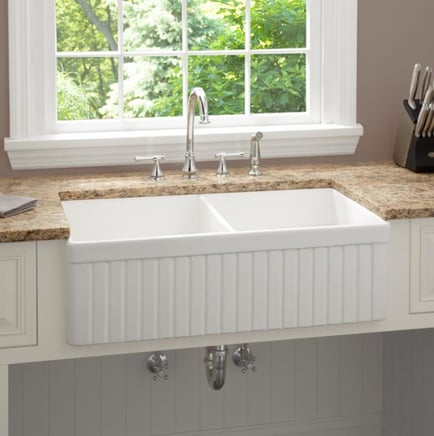 Farmhouse sinks are a wonderful choice for any Chicago Kitchen renovation. Previously thought of as a "traditional" kitchen accent, changes in material and style make it possible to add these large, user-friendly sinks in transitional and modern kitchens as well.
Farmhouse sinks are a wonderful choice for any Chicago Kitchen renovation. Previously thought of as a "traditional" kitchen accent, changes in material and style make it possible to add these large, user-friendly sinks in transitional and modern kitchens as well.
Add a Farmhouse Sink to Your Chicago Kitchen Renovation
Besides charm, farmhouse sinks are appealing because they are so darn functional. The large basin, without dividers, makes it easy to wash just about anything from your largest post and pans, baking sheets and cumbersome serving platters without having to hit a side or divider. Farmhouse sinks are sized like that because they originate from an era when indoor plumbing was a figment of people's imagination, which meant water was brought into the home manually from an outside well, river, creek, pond, etc.
They date back to the 17th century and there are two different styles. The Belfast sink is the deepest style, used in Ireland where water was more plentiful. The London sink is shallower, and it had no overflow because fresh water was scarce in that dense cityscape and every drop of water was needed. Back in those days, the kitchen sink was used to wash just about everything, including clothing and even small children.
Here are some more interesting tidbits about farmhouse sinks and their style points.
 Division is possible. While farmhouse sinks are traditionally one, large open vessel, they are also available with dividers. This can be handy for special china and items that must be washed by hand since it provides both a wash and rinse area. Just make sure the divisions are large enough for you so you don't pine for the single-basin option down the road.
Division is possible. While farmhouse sinks are traditionally one, large open vessel, they are also available with dividers. This can be handy for special china and items that must be washed by hand since it provides both a wash and rinse area. Just make sure the divisions are large enough for you so you don't pine for the single-basin option down the road.
Face set forward. One of the most distinguishing feature of a farmhouse sink is that the face of the sink is installed just in front of the cabinetry, rather than being set inside of it. This was to prevent water overflow from damaging cabinet faces, with the idea that any water that spilled over the edge would run down to the floor instead. While this isn't necessary anymore, this is still the way most farmhouse sinks are installed. They are also set slightly lower than the countertop - like an undermounted sink - making counter cleanup much easier and eliminating the debris and grime that can accumulate with a top-mounted sink option.
Materials. Farmhouse sinks are typically made from one of three materials: fireclay, porcelain or stainless steel. Fireclay is heated at extremely high temperatures, making the sink very resistant to chipping, scratches or cracks. It also has a lovely shine. Porcelain is another type of clay but it is not quite as durable as fireclay. On the other hand, it's more affordable. Stainless steel sinks have all the benefits of stainless steel and have allowed designers to incorporate them in non-traditional kitchens. Copper is another option and will eventually develop a beautiful patina.
Interested in incorporating a farmhouse sink into your Chicago Kitchen Renovation? Contact Kitchens & Baths Unlimited.
Photo Credit: Brushed Nickel Farmhouse Sink - Artesano Copper SinksPhoto Credit: White Divided Fireclay Farmhouse Sink - Houzz.com



